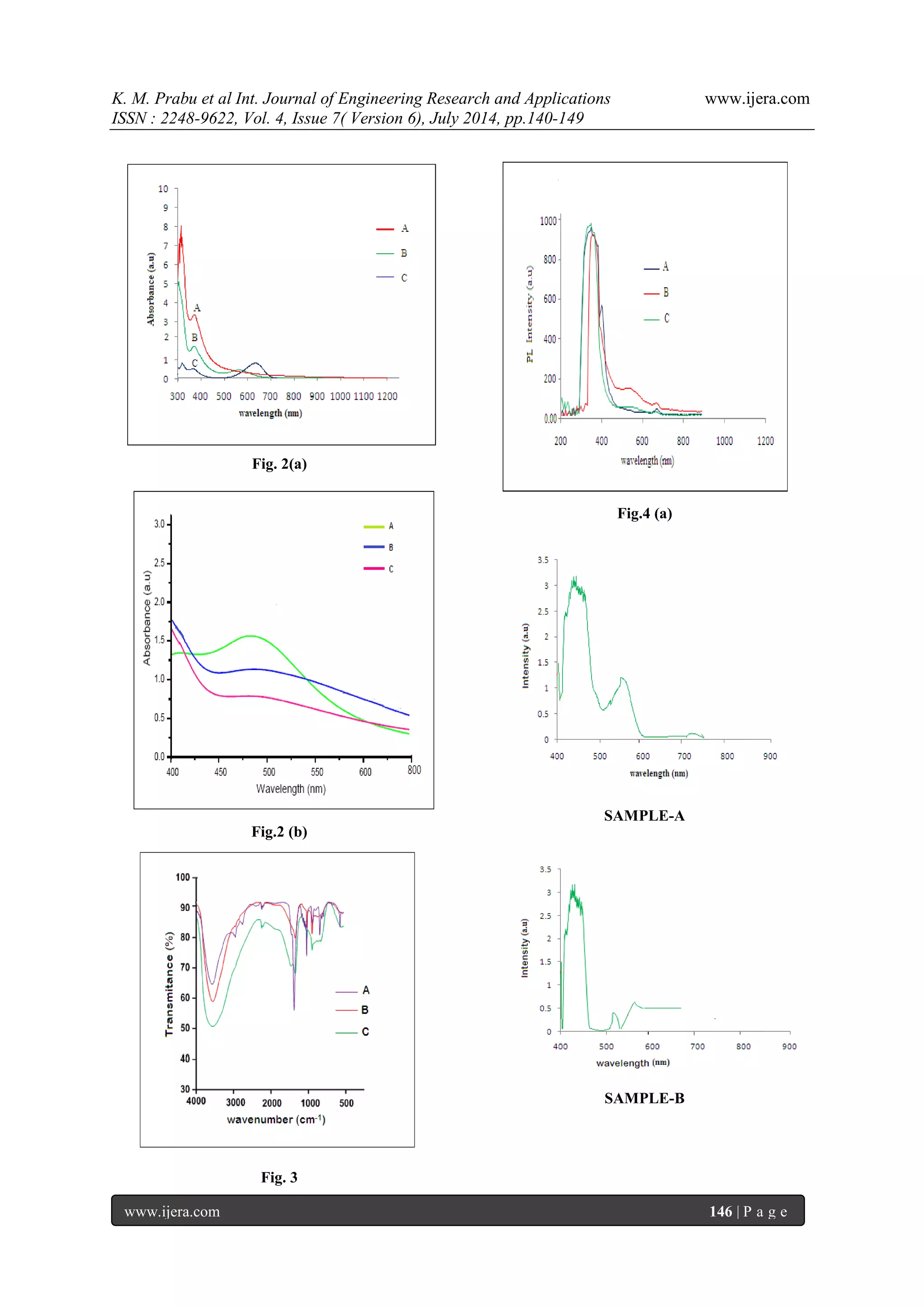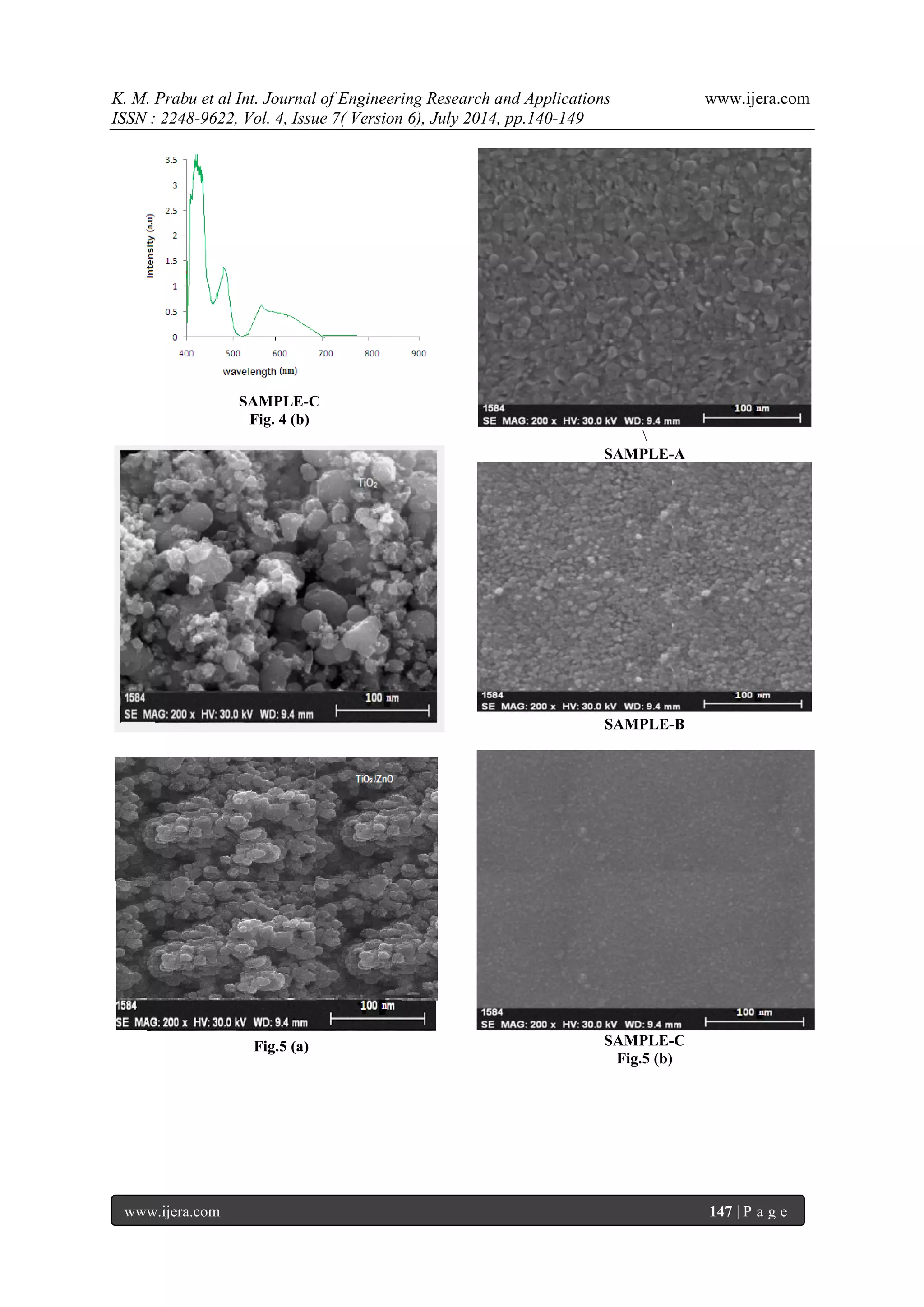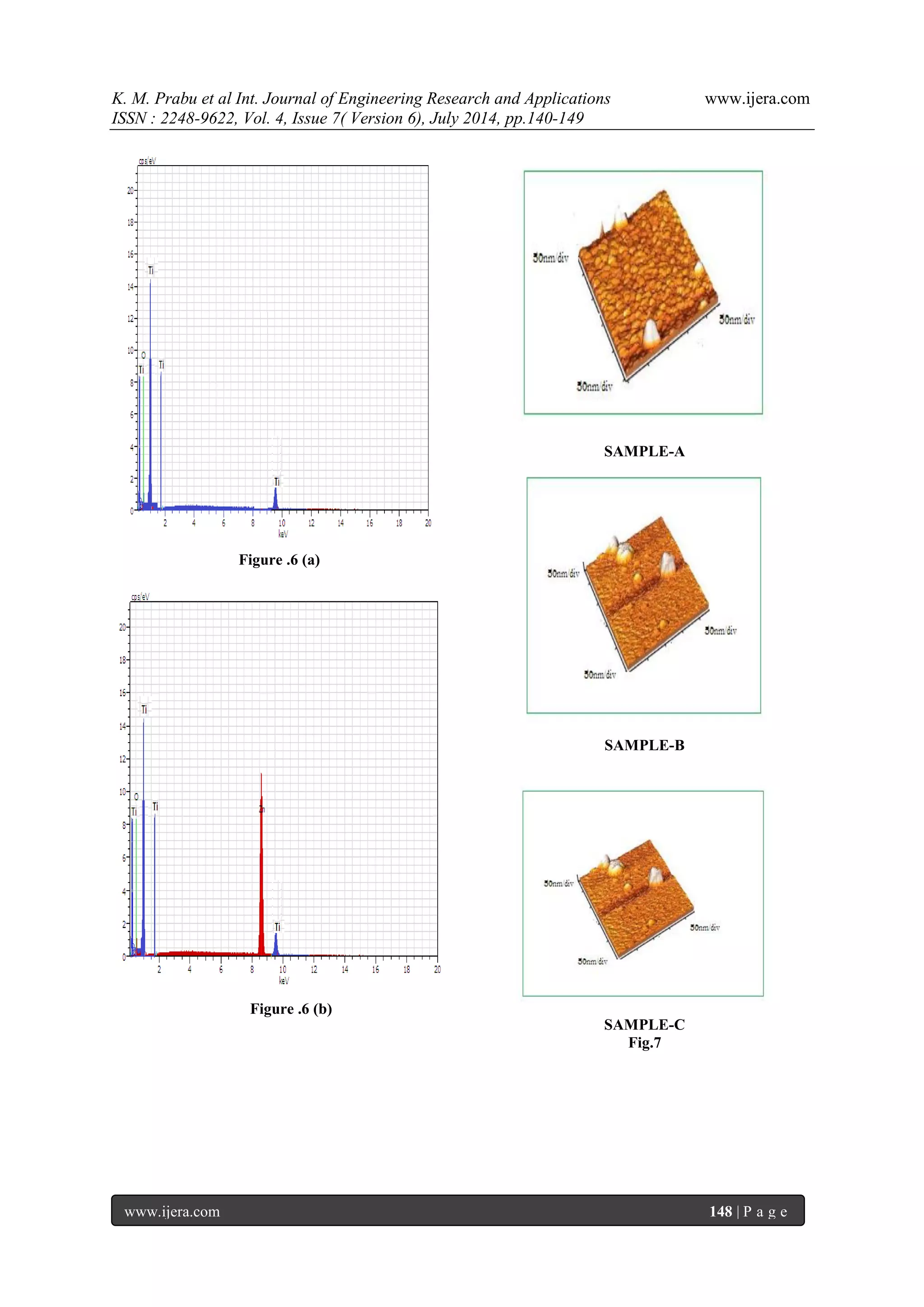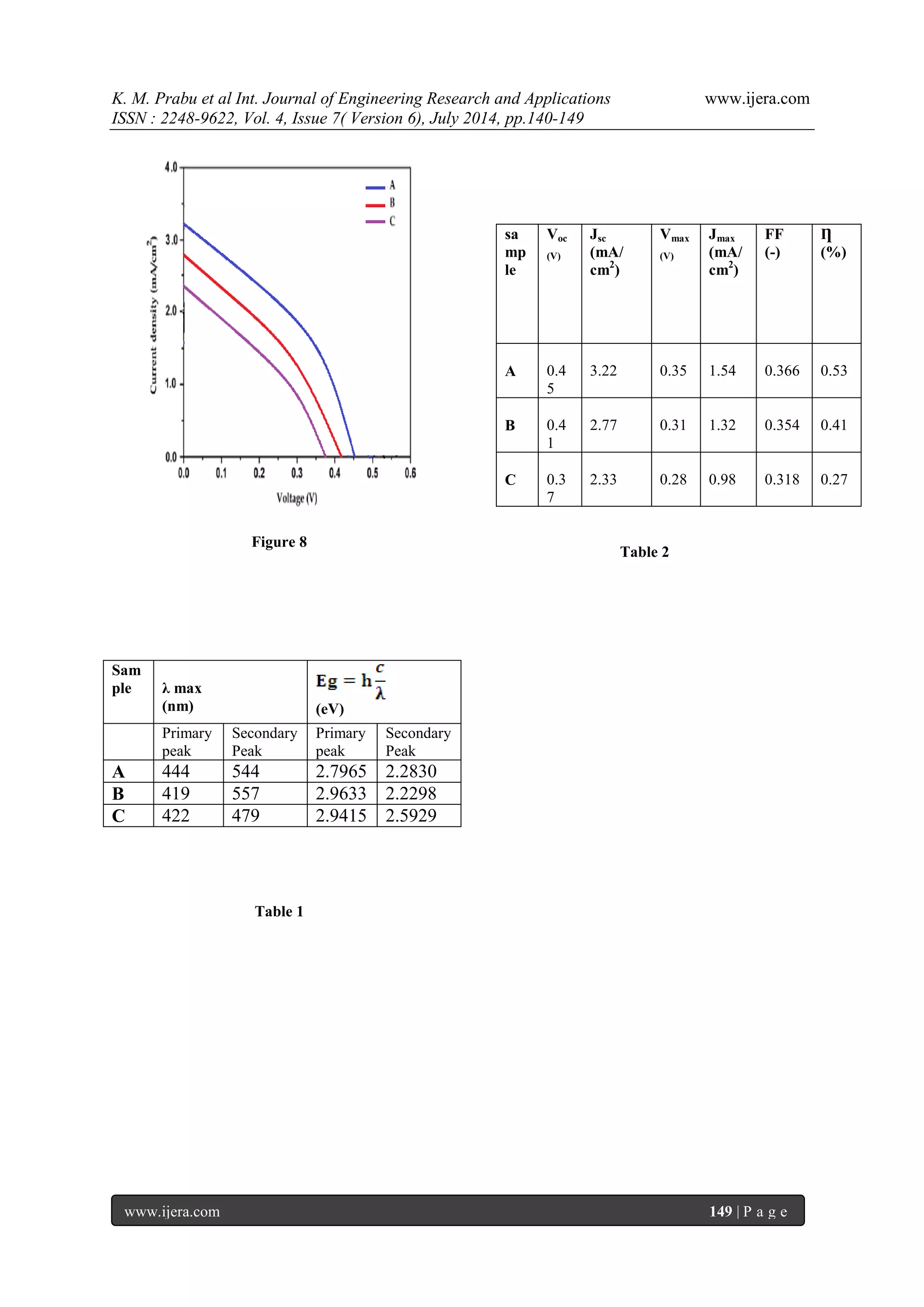This document discusses the development of natural dye-sensitized solar cells (NDSSCs) using Opuntia prickly pear dye and ZnO doped TiO2 nanoparticles prepared by the sol-gel method. It outlines the extraction process of the natural dye, the synthesis of the nanocomposite electrodes, and the characterization of their optical and photovoltaic properties. The study highlights the benefits of using natural dyes over traditional ones, emphasizing environmental and cost advantages while addressing their lower conversion efficiency.
![K. M. Prabu et al Int. Journal of Engineering Research and Applications www.ijera.com
ISSN : 2248-9622, Vol. 4, Issue 7( Version 6), July 2014, pp.140-149
www.ijera.com 140 | P a g e
Natural Dye-Sensitized Solar Cells (NDSSCs) From Opuntia Prickly Pear Dye Using ZnO Doped TiO2 Nanoparticles by Sol- Gel Method K. M. Prabu1, P.M.Anbarasan1,2 & S. Ranjitha3 1Department of Physics, Periyar University, Salem 636 011, Tamil Nadu, (INDIA). 1Department of Physics, Periyar University, Salem 636 011, Tamil Nadu, (INDIA). 2Centre for Nanoscience and Nanotechnology, Periyar University, Salem - 636 011, Tamil Nadu, (INDIA). 3 Velalar College of Engineering and Technology, Thindal, Erode - 638012, Tamilnadu, (INDIA). ABSTRACT Natural dye-sensitized solar cells (NDSSCs) have gained considerable attention in the field of solar energy due to their simple fabrication, good efficiency, and low production cost. Natural dyes are environmentally and economically superior to ruthenium-based dyes because they are nontoxic and cheap. However, the conversion efficiency of dye-sensitized solar cells based on natural dyes is low. One way to improve the DSSC performance is to enhance the absorptivity of extracted natural dyes. We investigated the influence of various factors in the extraction process, such as utilization of different extraction approaches, the acidity of extraction solvent, and different compounds of solvents on the optical absorption spectra. It was found that we could considerably enhance the optical absorptivity of dye and consequently the performance of DSSC by choosing a proper mixture of ethanol, methanol and water. In this study, a photo electrode using ZnO doped TiO2 nanoparticles was prepared by sol-gel method. In this paper we investigate the optical absorption, functional group, surface morphology and elementary composition of pure TiO2, ZnO doped TiO2 nanoparticles and opuntia prickly pear dye extract by using UV-Visible, PL-Studies, FT-IR, FE-SEM and EDS analysis. Finally photocurrent-voltaic characterization of nanocrystaline natural dye solar cell using I-V studies. It was found that the levels of short- circuit current (Jsc), open-circuit voltage (Voc), fill factor (FF) and overall conversion efficiency (η).
Keywords - ZnO doped TiO2 electrode, sol-gel method and opuntia prickly pear dye.
I. INTRODUCTION
Solar electricity is a steadily growing energy technology today and solar cells have found markets in variety of applications ranging from consumer electronics and small scale distributed power systems to centralized megawatt scale power plants [1] .The conversion of solar radiation to electrical energy has become more and more important because sunlight is a clean and limitless energy source compared to the traditional fossil energy sources. Up to now, solid state junction devices based on crystalline silicon needs high purity required in a form of a thin wafer and hence a large amount of energy is required for purification and crystal growth [2]. An important new class of solar cell that can significantly lower energy requirements in comparison to other conventional solar cells, and which may greatly reduce costs, is the Dye sensitized solar cell [3]. Dye-sensitized solar cells (DSSCs) were first proposed by Gratzel in the early 1990's. They developed a DSSC with energy conversion efficiency exceeding 7% in 1991 and 11.4% in 2001 by combining nanostructure electrodes to efficient charge injection dyes. A DSSC is the third generation photovoltaic device for low cost conversion of solar energy into electrical energy.
The TiO2 has been widely studied for efficient DSSCs, and a power conversion efficiency of 11% was reported. Moreover, ZnO nanoparticles were investigated for DSSCs. The working electrodes of DSSCs fabricated using ZnO nanoparticles have achieved the second highest efficiency after TiO2 [4]. Recent studies have shown that metal oxides such as ZnO, SnO2, Nb2O5, but mainly TiO2, have been successfully used as photo-anode when a dye is absorbed in the interior of the porous layer [5]. Another crucial parameter in the fabrication of DSSCs is the sensitizing dye. Due to the dye significant role, considerable interest has been directed towards the development and improvement of new families of organic dyes and of metal complexes. So far, the most efficient dye is found to be Ru (II). This complex have a number of interesting features such as good absorption, long excited lifetime, and highly efficient metal-to-ligand charge transfer. The disadvantages of these complexes are high cost and sophisticated preparation techniques. Therefore, alternative organic dyes such as natural dyes have been studied intensively. The main features of natural dyes are their availability, environmental friendly and low in
RESEARCH ARTICLE OPEN ACCESS](https://image.slidesharecdn.com/v04706140149-140909040619-phpapp01/75/Natural-Dye-Sensitized-Solar-Cells-NDSSCs-From-Opuntia-Prickly-Pear-Dye-Using-ZnO-Doped-TiO2-Nanoparticles-by-Sol-Gel-Method-1-2048.jpg)
![K. M. Prabu et al Int. Journal of Engineering Research and Applications www.ijera.com
ISSN : 2248-9622, Vol. 4, Issue 7( Version 6), July 2014, pp.140-149
www.ijera.com 141 | P a g e
cost. In general, a DSC comprises a nanocrystalline ZnO doped TiO2 electrode modified with a dye fabricated on a transparent conducting oxide (TCO), platinum (Pt) counter electrode and an electrolyte solution with a dissolved iodide ion/tri-iodide ion redox couple between the electrodes [6]. In this work we describe first the preparation of ZnO doped TiO2 nanostructure, followed by the process of dye extraction from opuntia prickly pear. In the second part we describe the solar cell preparation using opuntia prickly pear dye extracts from different solvents namely methanol, ethanol and water. In the third part we examine the optical absorption, functional group, optical band gap, surface morphology and elementary composition of pure TiO2, modified TiO2 nanoparticles and natural dye extracts by using UV-Visible, FT-IR, PL, FE-SEM & EDS analyses. Finally overall conversion efficiency for opuntia prickly pear dye extracts from different solvents was determined using photovoltaic characterization [7-10].
II. MATERIALS AND METHODS
2.1. Chemicals Used Most of the Chemicals used in the research are standard chemicals that are normally available in the laboratory. Special materials for DSSC such as Plasitol, Idolyte TG 50 & FTO-glass are bought from Solaronix. The chemicals used in this study were titanium tetrachloride, zinc acetate dehydrate, benzyl alcohol, absolute ethanol, acetyl acetone, Methanol, Isopropanol, DFM solvent, Triton X-100, Polyethylene glycol, Idolyte TG 50 and diethyl ether were bought from Sigma-Aldrich. All the chemicals were used without further purification [11]. 2.2. Preparation of ZnO/TiO2 Nanocomposites
Metal oxide nanoparticles attract great attention in recent years on account of their special electronic and chemical properties. Among the metal oxide semiconductors, TiO2 and ZnO have been investigated extensively due to their chemical stability and efficient photo catalytic properties. In this paper, ZnO-doped TiO2 nanoparticles with high photo catalytic activity were synthesized by sol-gel method. The sol-gel method is a versatile process used for synthesizing various oxide materials because it allows very simple control of particle size and the experimental process. The major advantages of this method are high purity of precursors and homogeneity of the sol-gel products with a high purity of physical, chemical, and surface morphological properties. The precursors are used for obtaining composites with molar ratio of 9:1 (TiO2: ZnO).The reactions were performed in a regular glass beaker at a controlled heating. For the preparation of nanopowder, one gram zinc acetate dehydrates was dissolved in 5 ml absolute ethanol and fed into 75 ml benzyl alcohol. Thus, to a beaker containing the obtained mixture of 4 ml TiCl4 was slowly added under constant stirring at room temperature. Initially, the reaction mixture was coloured in orange-red and contained some white fluffy precipitates that are completely dissolved on mixing. The container was covered with a Petri dish and the reaction mixture was stirred continuously at 100o C for 10 hours. Thus obtained materials were left at 30°C for 10 days. The resulting white thick suspensions were centrifuged at 5000 rpm for 30 minutes. The white precipitates were then washed two times with absolute ethanol and diethyl ether .After every step of washing, the solvent was separated by centrifugation. The collected materials were dried in air overnight and then grinded into a fine powder. The obtained powders were annealed at 600oC for 5 hours. The combination of these methods fosters the generation of a stable structure between the TiO2 and ZnO. For most of the photo catalytic decomposition processes, photonic efficiency is relatively low, and furthermore, photo catalytic reactions on TiO2 nanoparticles can usually be induced only by ultraviolet light, which limits the application of TiO2 as a photo catalyst with visible light [12-14] 2.3. Substrate Cleaning Coated glass with highly F-doped Transparent Conducting Oxide (TCO) usually serves as a support for the dye-sensitized oxide. It allows lightly transmission while providing good conductivity for current collection. The Substrates are first dipped into acetone with ultrasonic bath for 20 minutes to dissolved unwanted organic materials and to remove dust and contamination material that are left on the substrates post manufacture. Another 20 minutes of ultrasonic bath in methanol is followed in order to remove the acetone and materials that are not cleansed or dissolved by acetone. Finally, a 30 minutes ultrasonic bath in isopropanol was needed to further remove the residual particles on the substrates.
2.4. ZnO/TiO2 Photoanode Deposition on FTO Glass Plate
It is very important to work with a fingerprint free F-doped Transparent Conducting Oxide (TCO), always gloves were used and FTO was cleaned with alcohol prior to use FTO was heated to 50°C at the beginning of the process to increase the adhesion and the scotch 3M adhesive tapes were applied on the edge of the conductive side of the FTO glass plate. The reason for applying tapes was preparing a mould such that nonsintered ZnO doped TiO2 has always same area and thickness for all samples. A certain proportions of ZnO doped TiO2 powder with ethanol, acetyl acetone; polyethylene glycol and triton(X-100) were mixing for 30 minutes in agate mortar. Then](https://image.slidesharecdn.com/v04706140149-140909040619-phpapp01/75/Natural-Dye-Sensitized-Solar-Cells-NDSSCs-From-Opuntia-Prickly-Pear-Dye-Using-ZnO-Doped-TiO2-Nanoparticles-by-Sol-Gel-Method-2-2048.jpg)
![K. M. Prabu et al Int. Journal of Engineering Research and Applications www.ijera.com
ISSN : 2248-9622, Vol. 4, Issue 7( Version 6), July 2014, pp.140-149
www.ijera.com 142 | P a g e
ZnO doped TiO2 colloidal was dropped on the conductive side of the FTO after the conductive side of the FTO was checked by the multimeter. Then, the ZnO doped TiO2 paste was uniformly distributed over the FTO by Doctor Blade method. Doctor blade means a film smoothing method using any steel, rubber, plastic, or other type of blade used to apply or remove a liquid substance from another surface. The term “doctor blade” is derived from the name of a blade used in conjunction with the doctor roll on the letter press. The term “doctor blade” eventually mutates into the term “doctor blade” [15]
2.5 Heat Treatment for Photo anode
The scotch 3M adhesive tapes were removed from the ZnO doped TiO2 coated FTO glass plate and plates were sintered at 450°C for 30 minutes in air. The colour of ZnO doped TiO2 becomes brown in the middle of the sintering process and then its colour changes to the brownish-white. This colour remained till the end of the sintering process. This is to ensure that the polymer or macromolecules in ZnO doped TiO2 colloid such as acetyl acetone can be removed, leaving tiny holes in nano layers, resulting in better dye absorption and better contact between ZnO doped TiO2 particles. In consequence, it optimizes the chances of electrons being excited by the photons and increases the amount of excited electrons entering into the ZnO doped TiO2 conduction band. 2.6. Preparation of dye sensitizer solutions The fresh opuntia prickly pear was collected from Uthangarai taluk, Krishnagiri district as shown in figure 1. The collected fruit is first washed with running water then washed with distilled water as removing the unwanted dust particles on the fruits. Then the outer layer of the fruit is removing then cutting by sharp knife and then we can extract the natural dye of the opuntia fruit. Approximately 10 ml natural dye extract was dissolved in 30 ml of methanol, ethanol and water. Then the pure solutions were filtered out from solid residues by extraction process. Further purification of the extract was avoided to achieve efficient sensitization using simple extraction procedures. The extractants were properly stored, protected from sunlight and used further as sensitizers in DSSCs .The photograph of dye dipped FTO glass plate as shown in Fig. 1(b) 2.7. Preparation of Counter Electrode
The platinization procedure given by solaronix was applied because the material was taken from solaronix. Actually, this method is simply called thermal decomposition which is most widely used platinization procedure. Plastitol was applied on the surface by using a brush. All FTO glasses were sintered at 450°C for 15 minutes for decomposition which was the minimum required calcinations condition according to the procedure [16].
2.8. Nano crystalline Dye Sensitized Solar Cell Assembly Sensitized ZnO doped TiO2 photo-anode and the counter electrode was stacked together face to face and the liquid electrolyte, Idolyte TG 50 solution drop penetrated into the working space and counter electrode via capillary action. The two electrodes were held with binder clips [17-20].
III. RESULTS AND DISCUSSION
3.1 UV-Visible Spectroscopy The UV-visible spectral studies of the opuntia prickly pear dye extracts were carried out by using Lambda 35 model UV-visible spectrometer in the range of 200 to 1200 nm. The opuntia prickly pear dye is extracted from different medium such as methanol, ethanol and water corresponding to samples A, B, and C respectively as shown in figure.2 (a). The optical band gap of the opuntia prickly pear was determined from the absorption spectra using the relation Eg= hc/λ, where h is Planck’s constant, c is speed of velocity of light and λ is the cut-off wavelength. The broad absorption and sharp intense peak is obtained in between 350 to 450 nm. In the sample A obtained at longer wavelength compare to other samples. The peak at 411 nm and 465 nm observed at sample -A corresponding to band gap value of 3.02 eV & 2.6 eV respectively. In the sample B the sharp intense peak observed at 408 and 441nm and its corresponding band gap value is 3.04 eV and 2.8 eV respectively. In the sample C the sharp intense absorption peak is observed at the wavelength of 429 nm and its corresponding band gap value is 2.89 eV. These results concluded that the sample A belongs to the small band gap value compare to the other samples. The absorption spectrum of opuntia prickly pear dye in methanol shows the entire visible region. It is a good condition for solar cell applications. The UV –Visible absorption spectra of dye dipped FTO glass plate as shown in figure.2 (b). The broad absorption peak is obtained in the visible region. 3.2 Fourier Transform Infrared Analysis (FT-IR)
The Fourier transform infrared (FTIR) Spectra of opuntia prickly pear dye extracted were recorded on Perkin Elmer spectrometer using KBr pellet technique in the range of 3500 – 500 cm-1. FTIR spectra of opuntia prickly pear dye extracted from methanol, ethanol and water as shown in figure 3. From the sample A the peak absorbed at 3565 cm-1is due to presence of O-H stretching in the compound type of alcohols, phenols. The peak absorbed at 2891 cm-1 is due to presence of C-H stretching in the compound type of hydrocarbons. The peak absorbed](https://image.slidesharecdn.com/v04706140149-140909040619-phpapp01/75/Natural-Dye-Sensitized-Solar-Cells-NDSSCs-From-Opuntia-Prickly-Pear-Dye-Using-ZnO-Doped-TiO2-Nanoparticles-by-Sol-Gel-Method-3-2048.jpg)
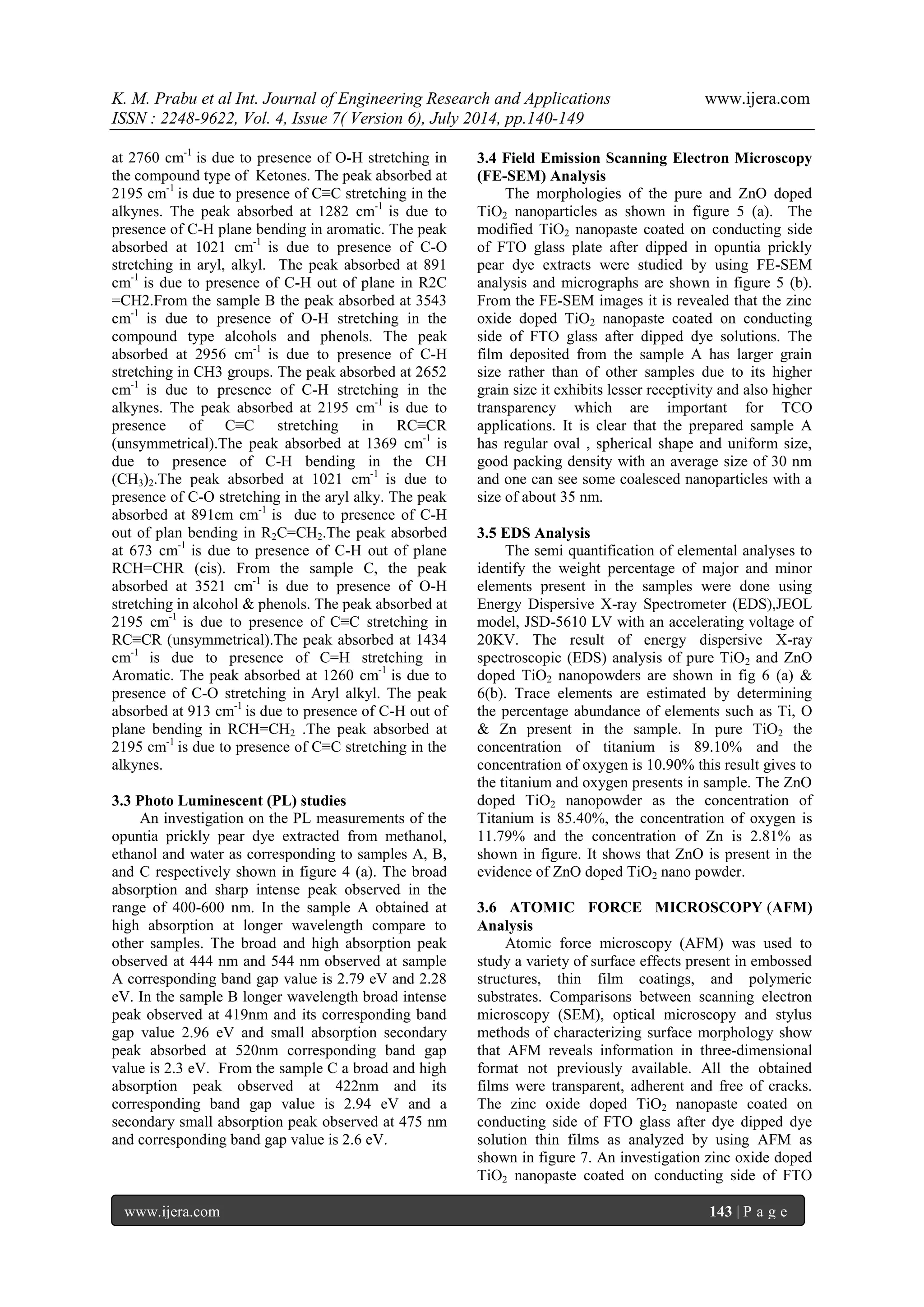
![K. M. Prabu et al Int. Journal of Engineering Research and Applications www.ijera.com
ISSN : 2248-9622, Vol. 4, Issue 7( Version 6), July 2014, pp.140-149
www.ijera.com 144 | P a g e
glass after opuntia preakly pear dye extracted from the solvent methanol, ethanol and acetone as shown in figure. 7 (a), (b) & (c) corresponding to samples A, B, and C respectively. The thin films showed homogeneous morphology surfaces with spherical particles of regular size and uniform distribution. The particle diameter was measured at different points of the surface by particle analysis tool and the average size calculated was about 17 nm. The mean roughness measured for this sample was 0.84 nm. The film deposited from the sample A has larger grain size rather than of other sample due to its higher grain size it exhibits lesser receptivity and also higher transparency which are important for TCO applications. It is clear that the prepared sample A has regular spherical shape and uniform size, good packing density compare to other samples 3.6. Photocurrent-Voltage (I-V) Characteristics of the DSSC Photovoltaic measurements were carried out using a halogen light source that was focused to one sun at Air Mass (AM) 1.5, at the surface of the cells. The spectral output of the lamp was matched in the region 350 nm and 800 nm with the aid of a Schott KG-5 sunlight filter so as to reduce the mismatch between the stimulated and the true solar spectrum to less than 2%. The current-voltage characteristics of the cells were determined by biasing the cells externally and measured the photocurrents is shown in figure 8. The overall photo conversion efficiency (η) is calculated from the integral photocurrent density (Jsc), the open circuit photocurrent (Voc), the fill factor (FF) of the cell, and the intensity of the incident light (Pin). From the figure 8 & table 2 shows the conversion efficiencies of DSSCs fabricated using opuntia prickly pear in different medium such as methanol, ethanol and acetone for samples A, B & C respectively. The open-circuit voltage (Voc), short-circuit current density (Jsc), fill factor (FF) and conversion efficiency (η) of the Sample-A was, Voc=0.4562 V, Jsc=3.2222 mA/cm2, FF=0.3669 and (η) is 0.5392 %, the Sample-B was Voc=0.4187 V, Jsc=2.778 mA/cm2, FF=0.3543, and (η) is 0.4120 %, the Sample-C was Voc=0.375 V, Jsc=2.33mA/cm2, FF=0.3543, and (η) is 0.2782 % respectively. In the present study, sample A has higher conversion efficiency compared to the other samples.
IV. CONCLUSION
The pure and ZnO doped TiO2 nanopowders were synthesized by sol-gel method to enhance the solar energy conversion efficiency. From the UV- Visible absorption spectra of opuntia prickly pear dye in methanol shows that the small band gap in the entire visible region and it is a good condition for the solar cell applications compare to other samples. The opuntia prickly pear having different functional groups is identified for the both samples and vibration assignment has been carried out by the FTIR spectral analysis. The PL spectra of the opuntia prickly pear dye in methanol gives the relation between solar energy conversion efficiency, spectroscopic properties and also obtained cut-off wavelength. The 3D image of atomic force microscopy (AFM) was used to study a variety of surface effects present in embossed structures, thin film coatings, and polymeric substrates. From the FE- SEM results give the average particle size of pure and synthesized nanoparticles is measured as 30 nm and 25 nm. It shows the synthesized particles size are decreased compared to pure TiO2. In this EDX analysis Zn and O is present in the evidence of ZnO doped TiO2 nano powder. In the photovoltaic measurements were carried out the open-circuit voltage (Voc), short-circuit current density (Jsc), fill factor (FF) and energy conversion efficiency (η) of the Sample-A, B & C. The sample-A showed the excellent solar energy conversion efficiency compared to other samples. REFERENCES
[1] Janne Halme “Dye-sensitized nanostructured and organic photovoltaic cells: technical review and preliminary tests” February 12, 2002
[2] D. Arun Kumar, Francis P. Xavier and J. Merline Shyla “Natural dye sensitization of TiO2 Thin Films using Lawsone dye extracted from Lawsonia Inermis for Solar Cell Applications” Archives of Applied Science Research, 2012, 4 (5):2122-2132 ISSN 0975-508
[3] Adenike. O Boyo & Henry. O. Boyo “Dye Sensitized Nanocrystaline Titania Solar Cell Using Laali Stem Bark (lawsonia inermis)” Transnational Journal of Science and Technology May edition vol. 2, No.4
[4] Sofyan A. Taya, Taher M. El-Agez, Hatem S. El-Ghamri, Monzir S. Abdel-Latif “Dye- sensitized solar cells using fresh and dried natural dyes” ijmsa. 2013; 2(2): 37-42 20130202.11
[5] Angel Ramon Hernandez-Martinez , Miriam Estevez, Susana Vargas , Fracisco Quintanilla and Rogelio Rodriguez “New Dye-Sensitized Solar Cells Obtained from Extracted Bracts of Bougainvillea Glabra and Spectabilis Betalain Pigments by Different Purification Processes” Int. J. Mol. Sci. 2011, 12, 5565-5576; doi:10.3390/ijms12095565
[6] Yasuo CHIBA, Ashraful ISLAM, Yuki WATANABE, Ryoichi KOMIYA, Naoki KOIDE and Liyuan HAN “Dye-Sensitized](https://image.slidesharecdn.com/v04706140149-140909040619-phpapp01/75/Natural-Dye-Sensitized-Solar-Cells-NDSSCs-From-Opuntia-Prickly-Pear-Dye-Using-ZnO-Doped-TiO2-Nanoparticles-by-Sol-Gel-Method-5-2048.jpg)
![K. M. Prabu et al Int. Journal of Engineering Research and Applications www.ijera.com
ISSN : 2248-9622, Vol. 4, Issue 7( Version 6), July 2014, pp.140-149
www.ijera.com 145 | P a g e
Solar Cells with Conversion Efficiency of 11.1% ” Japanese Journal of Applied Physics Vol. 45, No. 25, 2006, pp. L638– L640
[7] W. Choi, A. Termin, M. Hoffmann, J. Phys. Chem. 98 (1994) 13669.
[8] R. Asahi, T. Morikawa, T. Ohwaki, K. Aoki, Y. Taga, Science 293 (2001) 269.
[9] T. Ishii, H. Kato, A. Kudo, J. Photochem. Photobiol. A: Chem. 163 (2004) 181.
[10] J. Sun, S. K. Lee, Y. S. Lee, Applied Surface Science 257 (2011) 2164–2169.
[11] M. Fernandez-Garcia, A. Martinez –Arias, J. C. Hanson, J. A Rodriguez,Nanostructured Oxides in Chemistry: Characterization and Properties. Chem. Rev., 104,(9),4063- 4104,(2004).
[12] A. C. Pierre, Introduction to sol-gel processing, Kluwer Academic Publishers; Boston, 394(1998).
[13] Hee-Je Kim, Dong- Jo Kim, S.N. Karthick,, K.V. Hemalatha, C. Justin Raj, Sunseong ok, Youngson choe “Curcumin Dye Extracted from Curcuma longa L. Used as Sensitizers for Efficient Dye-Sensitized Solar Cells” Int. J. Electrochem. Sci., 8 (2013) 8320 – 8328.
[14] J. Chae, D.Young Kim, S. Kim, M. Kang, Journal of Industrial and Engineering Chemistry 16 (2010) 906–911
[15] A. I. Kontos, A.G. Kontos, D.S. Tsoukleries, M.C. Bernard, N. Spyrellies, P. Falaras, Journal of materials processing technology 1 9 6,243-248,(2008).
[16] T. Ma, M. Akiyama, E. Abe, I. Imai, Nano Lett. 5 (2005) 2543.
[17] H. Tian, L. Hu, C. Zhang, W. Liu, Y. Huang, L. Mo, L. Guo, J.Sheng, S. Dai, J. Phys. Chem. C 114 (2010) 1627.
[18] K. Ko, Y. Lee, Y. Jung, J. Colloid. Interface Sci. 283 (2005) 482.
[19] M.N. An’amt , S. Radiman, N.M. Huang , M.A. Yarmo, N.P. Ariyanto, H.N. Lim, M.R. Muhamad Ceramics International 36 (2010) 2215–2220.
[20] W. Xu, S. Dai, L. Hu, L. Liang, K. Wang, Chin. Phys. Lett. 23 (2006) 2288.
FIGURE CAPTION Fig.1 (a): Photograph of sample Fig.1 (b): Photograph of preparation of photo anode. Fig. 2(a): UV –Visible absorption spectra of opuntia prickly pear dye extract (sample-A- methanol, sample-B -ethanol and sample-C - water) Fig.2 (b): UV –Visible absorption spectra of dye dipped FTO glass plate
Fig. 3: FTIR spectral analysis of opuntia prickly pear dye extracts (Sample-A- Methanol, sample-B -Ethanol and sample-C -Water) Fig.4 (a): PL study of opuntia prickly pear dye extracts Fig. 4 (b): PL studies of after dye dipped FTO glass coated with ZnO doped TiO2 nanopaste Fig.5 (a): FE-SEM image of pure TiO2 & ZnO doped TiO2 Fig.5 (b): FE-SEM images of after dye dipped FTO glass coated with ZnO doped TiO2 nanopaste (samples-A, B, & C) Figure .6 (a & b): EDS analysis of pure TiO2 & ZnO doped TiO2 nanopowder Figure. 7 AFM images of 3D configuration in zinc oxide doped TiO2 nanopaste coated on conducting side of FTO glass after dye dipped (Sample-A, B &C ) Fig.8 Photocurrent-voltage characterization of opuntia dye extracts (sample-A- Methanol, sample-B -Ethanol and sample-C -Water) TABLE CAPTION Table.1: Parameters of PL Spectra. Table.2: Photovoltaic Parameters of samples A, B & C Fig.1 (a) Fig.1 (b)](https://image.slidesharecdn.com/v04706140149-140909040619-phpapp01/75/Natural-Dye-Sensitized-Solar-Cells-NDSSCs-From-Opuntia-Prickly-Pear-Dye-Using-ZnO-Doped-TiO2-Nanoparticles-by-Sol-Gel-Method-6-2048.jpg)
